
No, pair trading.

If you have a lower threshold to risk, you can pair trade say CTY with a higher yielder, some example Trusts shown in the above table but as always best to DYOR, and still receive a blended yield of 7% but with less risk.
Investment Trust Dividends

No, pair trading.

If you have a lower threshold to risk, you can pair trade say CTY with a higher yielder, some example Trusts shown in the above table but as always best to DYOR, and still receive a blended yield of 7% but with less risk.

If you look across the investment companies’ space, it is clear there is still strong demand for trusts that can provide investors with an attractive level of income which is reliable and, ideally, has some degree of both inflation protection and capital preservation. Despite the environment of higher interest rates that has prevailed over the last couple of years, trusts that can offer investors a decent stable yield have generally traded close to asset value, or at a sensible premium, and have been able to issue stock and grow – CQS New City High Yield is one example that quickly comes to mind.
Given this, we often get asked questions about what factors investors need to think about if they are looking for income from investment companies. With the end of the year approaching, and some investors making plans for 2025, it seemed a good time to look at the more common income-related questions we get asked and show some of the opportunities that are on offer. For those that want to know more about income in general, our weekly show included a special panel discussion looking at income.
This really depends on the yield of the underlying assets. Some funds invest in assets that may have limited or no prospect of capital growth, and investors will require a higher yield to compensate for that. Many fixed income investments fall into this category as the bulk of their returns comes in the form of income. At the other end of the spectrum there are funds focused on equity investments in businesses that are at an earlier stage in their life cycle. These companies tend to reinvest the bulk, if not all of their profits, back in the businesses to fund growth. As a consequence, these businesses will throw off little or no cash to their investors, whose returns will come in the form of capital growth rather than income, and yields will be low or non-existent. Growth capital funds such as Chrysalis are an obvious example. Then there is everything else in between.
Another important consideration is that some underlying assets are riskier than others. Risk can take many forms such as greater price volatility, higher default risk, greater income variability or greater regulatory risk. Such investments will need to offer an additional return to compensate investors for this additional risk. This may come in the form of higher potential capital growth, or it may come in the form of a higher yield. One way of illustrating this is to compare the yields on investment grade and high yield bonds. The latter is deemed riskier, and investors require a higher yield as a result.
It is often said that some stocks are cheap for good reasons, but their low share prices can amplify their yields making them appear attractive. Value traps, as they are frequently called, may look cheap but, if a business or asset is fundamentally flawed, its price can continually spiral downwards as its profitability or returns are eroded. In the extreme, investors may lose all of their investment. This is why, when it comes to yield, biggest is not always necessarily the best when selecting income investments, and it is important to look at other factors as well.
Diversification is important in any portfolio but, if deriving a certain level of income is key to your investment objectives, it is important not to be overly exposed to any particular type of income stream. It also follows that, if income is important, capital preservation is also likely to be important for the simple reason that, if capital is lost, it is no longer be able to earn an income. It is therefore important to spread this risk and have a mix of exposures, with different asset types and geographies (this can spread currency risk, political risk, and regulatory risk).
We explore a range of funds from different sectors below and we would suggest investors do not focus on just one or two but should spread their risk more widely. It is worth remembering that funds that are well diversified, or perhaps offer an exposure that is otherwise difficult to access and so may act as a good diversifier, may experience stronger demand, and offer a lower yield. The compensation is that they should either offer more stable income themselves or serve to bring greater stability to an investors’ overall portfolio.
The sustainability of income is another hot topic for income investors and the reality is that its importance will depend on an individual’s own personal circumstances. For example, someone who is further on in their retirement will likely prefer lower risk, or less volatile, investments that offer greater certainty of income at the expense of capital growth or possibly even eroding their capital. Others who wish to derive income for a long time to come, will be much keener to see that income growing as well. This is why investors who have a longer time horizon will tend to have greater exposure to equities and less to fixed income, and vice versa.
Related to this, we are often asked, is it okay to pay some income out of capital or should it just be from the revenue account or even just the current year’s revenue? There has been a lot of debate around these topics and, while there are strong views on the differing sides, a lot of it comes down to personal preferences. However, we would argue that if investors are able to rely on income, payments need to be sustainable over the longer-term.
If you are investing in a fund that owns income generating assets, it makes sense to us that, for the majority of the time, dividends should be covered and, ideally, such funds should also be gradually adding to their revenue reserves, allowing them to draw on these to maintain the dividend when there is a down year. This is a key advantage of the closed-ended structure, and we see little point in income funds having revenue reserves if there is no intention to draw on them in years when there has been a shock to income.
However, if funds are invested in income generating assets, yet are continually drawing on their revenue reserves, this suggests that they are over-distributing and running down their capital. As noted above, this may suit some investors but not all. Our personal preference is for funds not to over-distribute in this way. However, we think there is one exception that investors should be aware of. There are a number of funds that perhaps derive some income but have also been good at generating capital growth too and, in a world that values income, they convert some of that capital growth to income to make themselves more attractive to investors.
Once again, this comes down to personal preferences, but we think that, in such instances, if the dividend is well covered by the combination of income and capital returns, this approach makes more sense. Patria Private Equity (PPET) is an example of a fund that has done this well. It has a natural yield of around 2-2.5% on its portfolio (contrary to popular belief, a lot of private equity is cash generative) but amplifies this to around 4% by drawing on its capital profits. It has plenty of room to do this having generated annualised NAV total returns of 14.5% over the past 10 years.
In the current market environment, we think a global equity strategy should offer a yield of around 4% (the median for the AIC’s global equity income sector is just over 4% at the time of writing) and would argue that it is difficult for a trust to position itself as an income vehicle if its yield is below 3%.
Another popular trust that is issuing a lot of stock is JPMorgan Global Growth & Income (JGGI). It sets a target dividend each financial year equal to at least 4.0% of the NAV of the company as at the end of the preceding financial year, topping up the income it generates from capital. JGGI has performed strongly (it ranks in first place in its sector over five years with an annualised NAV total return of 15.7% and is also the top trust over 10 years with an annualised NAV total return of 13.9%) and trades at modest premium (1.3% at the time of writing versus a median discount for the sector of 8.3%) as a result.

UK funds
The UK equity market has traditionally been a good market for those seeking income as it has a stronger focus on paying dividends than almost if not all other markets (the US, for example, pays a lower yield but tends to make up for this at least in part with share repurchases). The UK has been out of favour with global investors since Brexit but there are signs that this is gradually improving.
Nonetheless, currently investors can still expect a yield premium from UK equity income funds over global equity income funds of around 1% (the median for the AIC’s UK equity income sector is 4.90% at the time of writing). The best performing fund in this peer group is Law Debenture, which has provided NAV total returns of 9.2% and 8.3% over five and 10 years respectively and consequently trades around par (LWDB is at a premium of 0.8% at the time of writing versus a median discount for the sector of 8.9%). As its income is boosted by its professional services business, its managers can invest in slightly lower yielding but faster growing companies. Its yield of 3.6% is respectable but somewhat below the sector median. It was also a winner in QuotedData’s Investors’ Choice Awards for 2024, taking the ‘Best for long-term income’ award.
Another interesting fund in the UK equity space is Temple Bar (TMPL). It has benefited both from a change of manager in recent years (accompanied by a dividend cut) and its returns have picked up as its strong value style has come back into vogue in an environment where interest rates have been higher. It funds its dividends from its income and has provided an annualised NAV total return of 10.2% over the last three years. The yield is 3.6% but can be bought at a discount of 7.8% (all at the time of writing).
Utilities and infrastructure funds, including renewable energy infrastructure, are similar in that they all own long-lived assets that are cash generative and throw off predictable cash flows, often with a strong degree of inflation linkage, which makes them well-suited to providing income for investors. When interest rates were lower, these funds were in high demand and for a long time traded at premiums that reflected this. However, they derated as interest rates rose, extending their yields.
Today, the median yield in the infrastructure sector is 6.6%, with a median annualised NAV total return 5.6% over the last five years. The more debt focused funds, such as GCP Infrastructure, offer yields of c10%, which is noteworthy when you consider that its five-year annualised NAV total return of 5.6% is just above the median for the whole sector. The median discount in this sector is 21.3%, suggesting the potential for strong capital appreciation if this sector comes back into vogue, which could occur if interest rates continue to fall.
The renewable energy sector has a median yield of 8.5% and a median discount of 31.6% – these figures being larger and wider than those of the infrastructure sector because there is inherently less diversification within their assets and geographies, meaning they are more exposed to specific risks such as poor irradiation or wind speed, or a shift in the regulatory environment. Regardless, there are plenty of very good funds in this sector with hefty yields and strong track records of operational performance.
My colleague Andrew looked at this sector in more detail recently in his QD view of 8 November 2024 , so I won’t labour this here, but we would pick out funds such as Bluefield Solar (a yield of 9.4% and a discount of 24.6%) which has complemented its extensive solar portfolio with some wind assets (these work well together as the wind tends to blow more when the sun isn’t shining); Downing Renewables and Infrastructure, which is distinguished by its Swedish hydropower assets and yields 7.4% with a discount of 31.4%; NextEnergy Solar – another well-managed fund yielding 12.0% with a discount of a discount of 27.9%; and, for those who want a more diverse mix of assets (think anaerobic digestion plants, CNG refuelling stations and salmon farms to name but a few), Foresight Environmental Assets which yields 10.6% and sits on a discount of 33.9%.
Very high yields such as these would normally be taken as a sign of distress, but the reality for these funds is that their cash flows are fairly predictable for many years from now.
Alongside this, I would also highlight Ecofin Global Utilities and Infrastructure (EGL), which sits in the infrastructure securities sector. It has a diverse mix of infrastructure and utilities assets – both in terms of technology type and geography – and has benefited recently from the strong performance of its holdings in Vistra and Constellation Energy on the back of the surge of interest in AI. These power companies are amongst the very best performing stocks in the S&P 500 over the last 12 months providing total returns of 345% and 105% respectively, as the likes of Microsoft and Amazon look for security of energy supply for their power-hungry datacentres.
EGL has provided an NAV total return of 9.7% per annum over the last five years, yields 4.3% and can be purchased at a 12.1% discount. Anecdotally, we had the opportunity to meet its manager this week, who showed us that out of 102 listed infrastructure funds globally within Morningstar’s infrastructure universe, EGL ranked first over one year, seventh over three years and first over five years.
seatgeek promo code
blogangle.in/2024/02/seatgeek-promo-code-february…
Szymczyk75097@gmail.com
46.3.128.29
I’m really enjoying the theme/design of your website. Do you ever run into any browser compatibility issues? A number of my blog readers have complained about my website not working correctly in Explorer but looks great in Firefox. Do you have any suggestions to help fix this problem?
£££££££££££
Similar comments, I have no solution to the problem.
As 2024 draws to a close, we’ve asked the experts what 2025 has in store for markets, and the best investment opportunities

(Image credit: MicroStockHub via Getty Images)
By Dan McEvoy
In the run-up to Christmas and the New Year, many investors will be deciding on the best stocks, commodities and funds to invest in for 2025, to help navigate the complex but potentially rewarding global market environment.
While inflation and global instability remain areas of concern, investors who think carefully about where to invest for the year ahead can potentially benefit from potential upsides, including the expected impact of Donald Trump’s re-election on the stock market.
The UK stock market has struggled over recent years, but some experts believe that this now makes FTSE 250 stocks an attractive source of value. With UK interest rates now entering a cutting cycle, this could be one key source of diversification away from US megacaps.
Stay ahead of the curve with MoneyWeek magazine and get the latest news, analysis and expert opinion.

Bonds and commodities (especially gold), though, remain important components of a balanced portfolio.
“From an economic perspective, the environment is still quite benign,” Johanna Kyrklund, group chief investment officer (CIO) at Schroders, told a 2025 crystal ball webinar this month (November). “With inflation rolling over, we’ve seen a number of central banks start to cut rates, which is very helpful.”
Schroders expects the US economy to return to expansion in 2025. “We’re not expecting a hard landing,” says Kyrklund. This is based largely on labour market resilience, as well as positive indications from savings data, and expectations that fiscal spending is unlikely to cut back significantly.
“This combination of rates coming down and growth holding up – what we often refer to as a ‘soft landing’ – is very benign for markets.”
However, there are risk factors that need to be considered.
Trump’s tariffs, which herecently announced would be newly levied on imports from Canada and Mexico from the outset of his presidency, could fan global inflation. While Schroders’ baseline model paints a positive picture for markets, elevated global tariffs could, they believe, negatively impact global trade and weigh on US consumer spending.
“Generally, an environment where global trade is contracting is one where the pie is shrinking,” says Kyrklund.
However, Scott Klimo, CIO at Saturna Capital, feels that tariffs are unlikely to spread significantly beyond these countries. Mexico and Canada are in the firing line by virtue of the large trade deficits that the US runs with them, but as Klimo says in HANetf’s Partner Outlook 2025, “a global 10-20% tariff [is] unlikely, as the US runs trade surpluses with many countries, including Brazil, the United Kingdom, Spain, Australia, and the Netherlands”.
There is also the potential for the bond vigilantes to further fiscal spending in the US.
“Investors face a complex landscape” heading into 2025, Tom Stevenson, investment director at Fidelity International, tells MoneyWeek. US policy shifts, moderating inflation, and regional divergence all look set to influence the markets.
The global picture is in many respects harder to predict. “Outside the US, economies have struggled with stagnation and weak productivity,” Shaan Raithatha, senior economist at Vanguard, tells MoneyWeek. “Europe faces risks from global trade slowdowns, while China needs more aggressive policies to overcome structural issues.”
On the other hand, Kate Morrisey, head of asset allocation at Evelyn Partners, predicts a return to global growth next year.
“With Western and Eastern policymakers easing monetary policy, we could see global growth accelerate over the next 12 months,” she says.
The UK economy in particular will be heavily impacted by the question of how persistent inflation remains, and the knock-on effect this has on interest rates. On 5 December, the Bank of England (BoE)published data suggesting that 54% of British employers expect to raise prices in light of the increase to employer national insurance announced in the Autumn Budget.
This could lead to greater inflation. Seath, director of market insight at the Investment Association, predicts a “slightly more inflationary environment through 2025”.
As a result, markets expect the BoE to “reduce the pace and the scale of interest rate cuts”, Seath tells MoneyWeek.
In the short term, this complicates the picture as it relates to the government’s plan to return the UK to GDP growth; in Seath’s view, it could take longer than previously hoped, and this has a negative impact on the short term outlook for the UK’s equity market.
All the experts we’ve spoken to agree on one thing: the importance of diversification. In essence, while there are reasons to be optimistic about 2025, this optimism is laced with uncertainty for a variety of reasons, and the only way to hedge against this uncertainty is through a diversified portfolio.
“Diversifying investments that improve your portfolio resilience is very important,” says Kyrklund.
“While it is easy to create a narrative in favour of US equities, there are several scenarios which could quickly turn markets in a different direction,” Dan Coatsworth, investment analyst at AJ Bell, tells MoneyWeek.
So far they have responded positively to news of Donald Trump’s re-election, based on the assumption that he will throw his weight behind the stock market and adopt a pro-business, low-tax and low-regulation approach.
“It is well known that Trump views the US stock market as one of the most important barometers of economic performance and, as such, he will look to implement supportive policies,” says Morrisey. This could include reducing corporate taxation, and slashing regulations across the economy. Morrisey believes this “could facilitate greater innovation and efficiency with a resulting boost in productivity”.
However, a more pessimistic read on his upcoming second term complicates the picture. “Bears say many of his policies threaten to push up inflation and cause heightened geopolitical tensions, such as through a trade war,” says Coatsworth.
“We’ve had a very strong year for markets,” said Kyrklund. “The question is, can equity prices, in particular, continue to rise in 2025?”
Kyrklund believes that equities will continue to be “the main source of returns” in 2025, but says that the current stretched valuation of the S&P 500, in particular, poses a challenge.
“We need to be a little bit careful there – a lot of good news has been priced in,” she says. Similarly, Raithatha suggests “a cautious approach towards US equities due to elevated valuations”.
There could be potential in smaller US stocks. “Deregulation, tariffs and tax cuts should favour smaller, domestically-focused US companies,” says Stevenson. “These stocks have underperformed the tech giants over the past two years and valuations are less stretched as a result.”
Equity markets could, though, finally rotate away from the US megacaps that have dominated for the last two years. “I’d argue that if you move away from the megacaps in the US and look internationally, the valuations do look more attractive,” says Kyrklund.
Raithatha views UK equities, non-US developed markets, and emerging market equities as the best potential sources of . Emerging markets could, however, be dented by the headwinds facing China, including rising trade tensions and an insufficient fiscal stimulus.
The UK stock market is “cheap, offers attractive dividends, and contains lots of companies that might be in demand if the US market disappoints,” says Coatsworth.
Similarly, despite her concerns over the inflationary impacts in the UK, Seath highlights t UK stocks and shares are “cheaply valued”. Britain is also relatively stable politically compared to Europe’s other large economies, which could make it an attractive proposition to investors.
There could also be a tailwind for UK infrastructure stocks, driven by renewed emphasis on public investment. This, says Stevenson, could offer “steady, inflation-linked returns”.
Besides the UK, investors may want to consider Japanese stocks. As of 19 November, the Nikkei 225’s earnings yield stood at 4.9%, compared to the S&P 500’s 4.1%, according to Bloomberg data compiled by CME Group. Other valuation metrics such as price-to-sales and price-to-book valuations support the view that Japanese stocks areundervalued, especially compared to US counterparts.
While Japan looks interesting, “Europe looks more challenged, and recovery in China will be muted”, says Stevenson.
In general, Stevenson advocates avoiding US megacaps where possible due to stretched valuations. This could mean allocating to global income funds rather than tracker funds as a source of income, as the latter will be oversaturated with the tech megacaps.
Giulio Renzi-Ricci, head of asset allocation at Vanguard Europe, believes that “bonds are still back” and that yields are likely to remain above 4% across the curve in the US during 2025. He believes that bonds can act as a ballast for any long-term portfolio to offset fluctuations in other investments (particularly shares).
These high yields make bonds a particularly attractive investment at present, as they can provide a ‘coupon wall’, protecting positive returns even in the event of a modest interest rate rise, says Raithatha.
Kyrklund recommends holding bonds in a portfolio – but for income, rather than for diversification.
“Yields are still very attractive in bonds. [They are a] great source of return [and] income for clients,” she says. She also believes that they are currently “tactically cheap”.
Raithatha expects UK bonds to return 4.3%-5.3%, and global ex-UK bonds 4.5%-5.5%, to sterling investors over the next decade.
Rather than bonds, Kyrklund recommends commodities as a more effective means of diversifying away from equities in the current environment.
“Compared to the last decade, when commodities really offered no diversification, in this decade we have typically seen benefits from owning commodities from a diversifying standpoint.”
Investing in gold appears to be one particularly savvy route to diversification via commodities.
Gold has had a stellar year, and some could be forgiven for thinking this now isn’t a good time to buy gold. However, Kyrklund believes that it offers a solid hedge against currently elevated levels of fiscal spending as well as offering superior diversification from equities compared to bonds.
“Gold can be another hedge against any negative news from the US and inflation remaining sticky,” says Coatsworth. “Just look back to the 1970s, when commodities, notably gold and oil, did better than everything else during a period of lofty inflation and geopolitical tension, most notably in the Middle East.”
Copper is another commodity to keep an eye on in 2025. “The copper market is entering 2025 with a widening supply-demand deficit,” Jacob White, ETF Product Manager at Sprott Asset Management, says in HANetf’s outlook. This is driven by the combination of increasing structural demand for copper, given its importance to electricity transmission, and “persistent supply-side constraints”.

The first projection for the 1st quarter 2025.
Dividends for re-investment
Jan £590.00
Feb £552.00
Mar £1,087
£2,229.00
( Cash for re-investment £770.00 plus dividends still be received for December £1,857.00 )
£2,229 plus £150 = £2,379 x 4 = £9,516.00.
Ahead of fcast but all subject to change.
Stick to your task until it sticks to you, with a dividend re-investment plan you fail by the month not the year.
The Snowball’s view. If you buy NESF and the dividends flatline, in eight years time, you will have received all your capital back and achieved the holy grail of investing in that you have an income producing Trust that sits in your account at zero, zilch, nothing. If you re-invest the dividends into another income producing Trust, you will also have more income to re-invest in another income producing Trust.
The risk is the dividend is not maintained, so remember the rules.

Dear reader
I previously wrote in my article “what’s occurring”:
NESF might not be everyone’s cup of tea but at the end of the day when all’s said and done, is it tidy?
Thanks for reading The Oak Bloke’s Substack! Subscribe for free to receive new posts and support my work.
NESF is another FTSE250 company potentially for my ideas for 2025. The second of four FTSE250 companies in the OB 25 Ideas for 25. Don’t worry reader, I’ve not entirely turned my back on nano caps. Having started a list of 20 I was agonising over further ideas I felt carried merit. So I decided since the next year is (20)25 that the idea for OB 25 ideas for 25 had a nice ring to it. More for you to read, reader. More opportunities for harrumphers to harrumph about things. More for eagle-eyed readers to use along with their skill and timing to turn ideas into profitable outcomes.
And learning from fellow racer, Mr Arby, I’ve furthermore decided that one of these ideas will be weighted. More on that in a future article.
NESF is a large solar investment trust with 102 assets and capacity of 983MW. After years of trading at a premium to NAV, both its NAV and share price have fallen away, albeit its NAV has reverted to 2021 levels – do we see a clue there that temporary factors created “noise” which increased and then decreased its assets?
Yes.
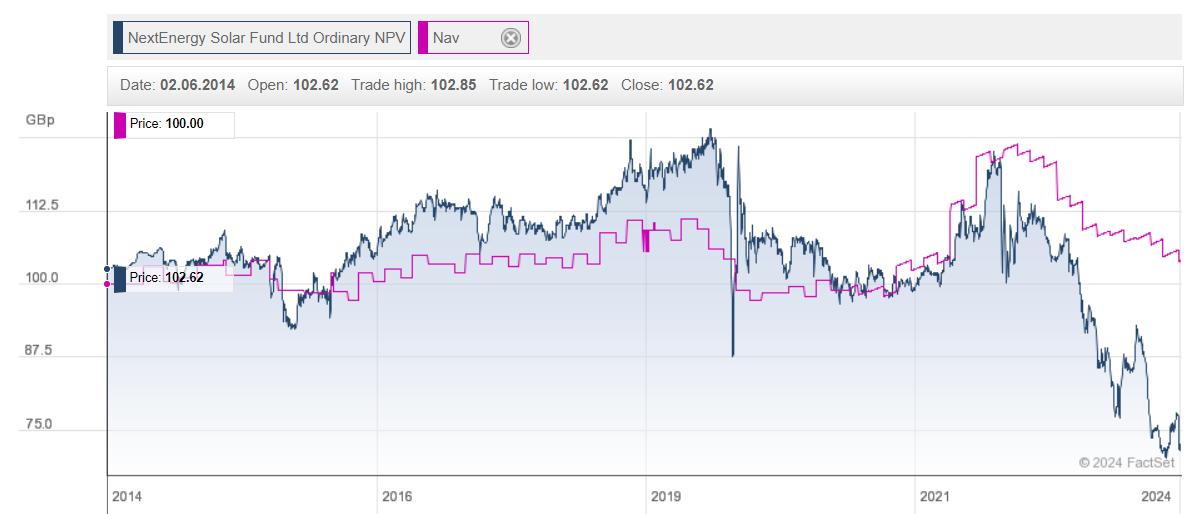
NESF has a large UK footprint, with 10% Italy, and 5% RoW. Its assets are long life, and 983MW capacity and 599GWh generated in 2023 tells us that the energy yield was 7.3% of capacity, while in 2022 the energy yield was 9.1% (599000/(933*365*24)). The yield fell to just 6.9% in 1H25
The yield was spot on to the average based on our world in data (you can click on the chart below). It reveals that capacity and generation are fairly consistent between countries. I had wrongly assumed that yield for the UK was lower than say Italy or the Sahara Desert, but the data doesn’t show that. So 85% of solar being in the UK isn’t the disadvantage I’d first imagined it would be. At least not using today’s technology.
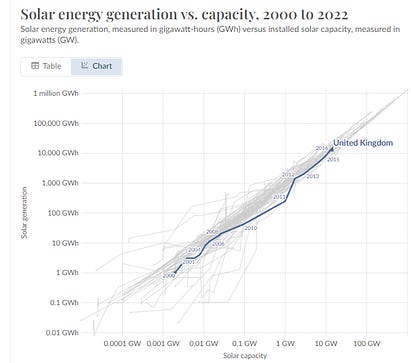
The answer to this apparent riddle/contradiction is a lower temperature offsets lower irradiance. While more irradiance means more power, more heat shortens the life of equipment and reduces the efficiency of solar too. That factoid gobsmacked me.
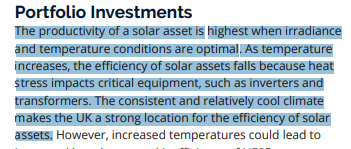
NESF appears to have a large portfolio of assets, with low costs of debt (70% fixed and 30% floating but on very advantageous rates of SONIA + 1.2% and +1.5%) and using asset sales to reduce the more expensive RCF debt. £21.8m of short-term RCF was paid down in the period to 30/09/24.
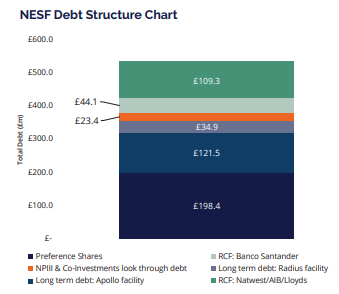
Revenue has a degree of protection from price fluctuations through hedging, ROC (renewable obligation certificates) and subsidies. About 90% of capacity is subsidised, so power prices alone only apply to 10%. Its 50MW of energy storage is live (70% owned) and 250MW is pre-construction
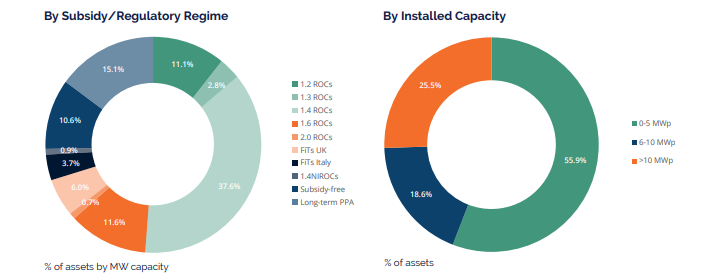
As at 30/9/24 NESF had agreed fixed UK pricing (hedged) covering 94.4% of budgeted generation for the 2024/25 financial year, 81% of budgeted generation for the 2025/26 financial year and 69% for the 2026/27 financial year, 62% for 2027/208 and 61% for 2028/2029.
Income in the September 2024 interim covers dividends 1.5X NESF proudly proclaim.
Show me the money the OB says. Read on to find out what I found.

Show me the money the OB says. Read on to find out what I found.
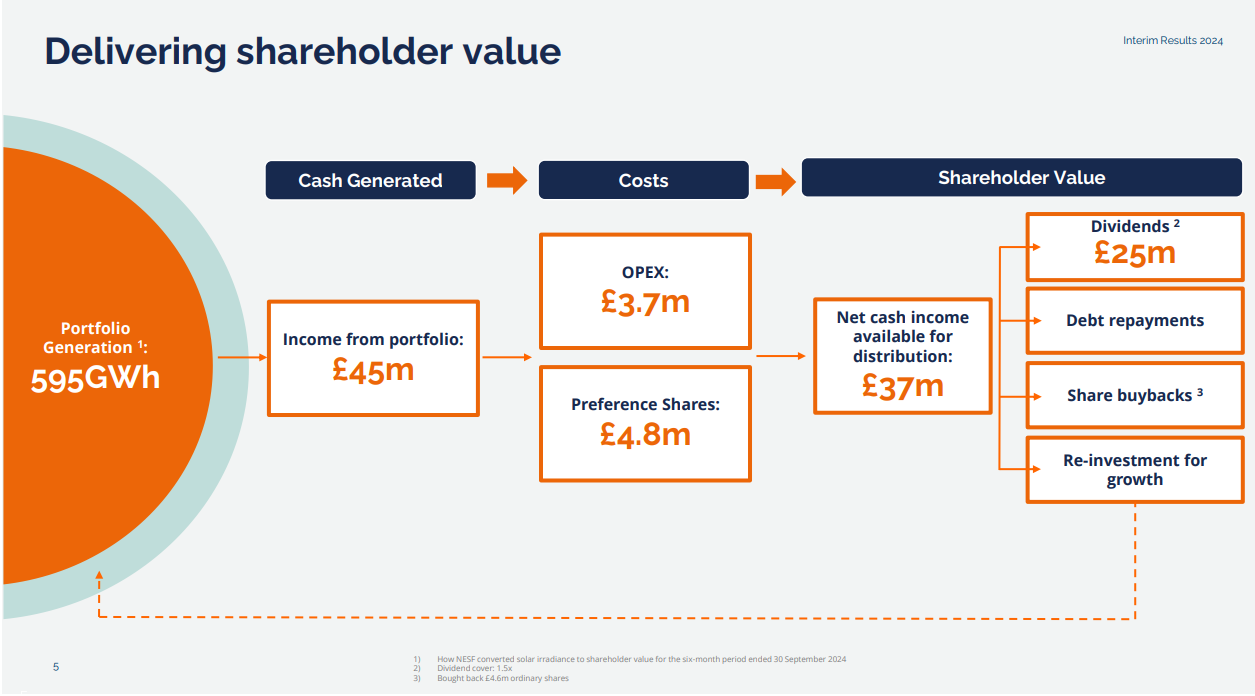
The forward yield is a very impressive 12%. (based on a 8.43p per share dividend). A 14.4% return when you consider the 2.4% buy backs.
Other points of note are its sales of assets as a 14%-21.5% premium to NAV (a further programme begins in 2025). Consider that vs NESF’s 28.2% discount to NAV. If 14% is indicative of the portfolio then the true discount to NAV is actually 37%.
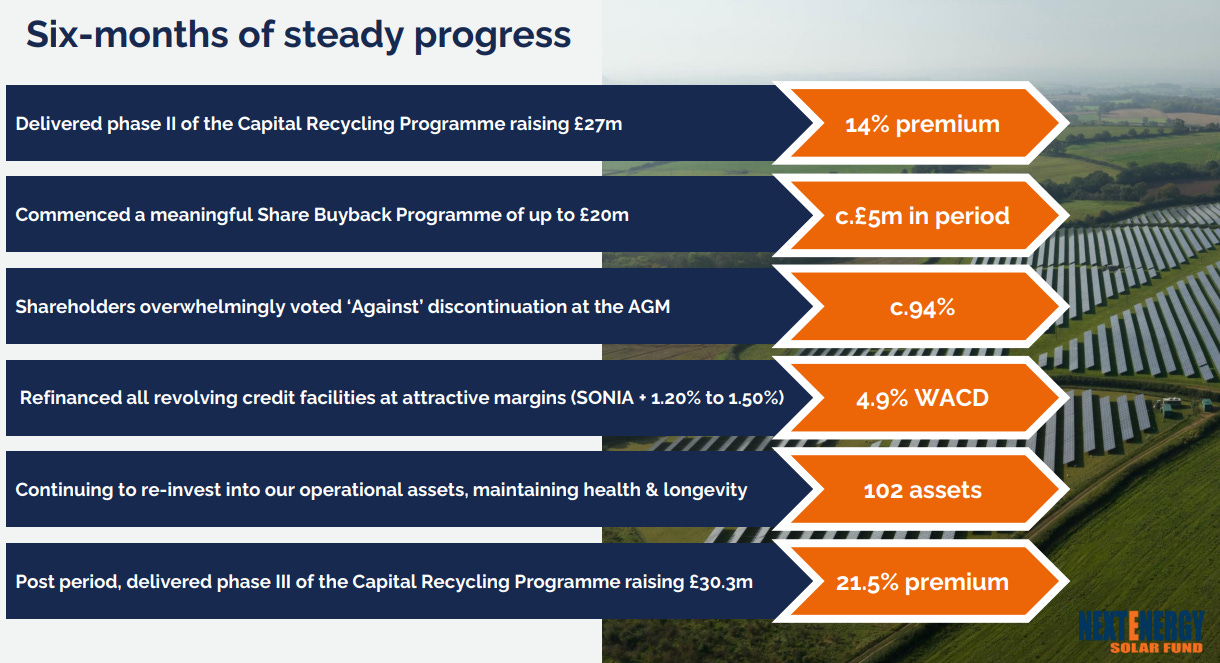
This is the operating portfolio:
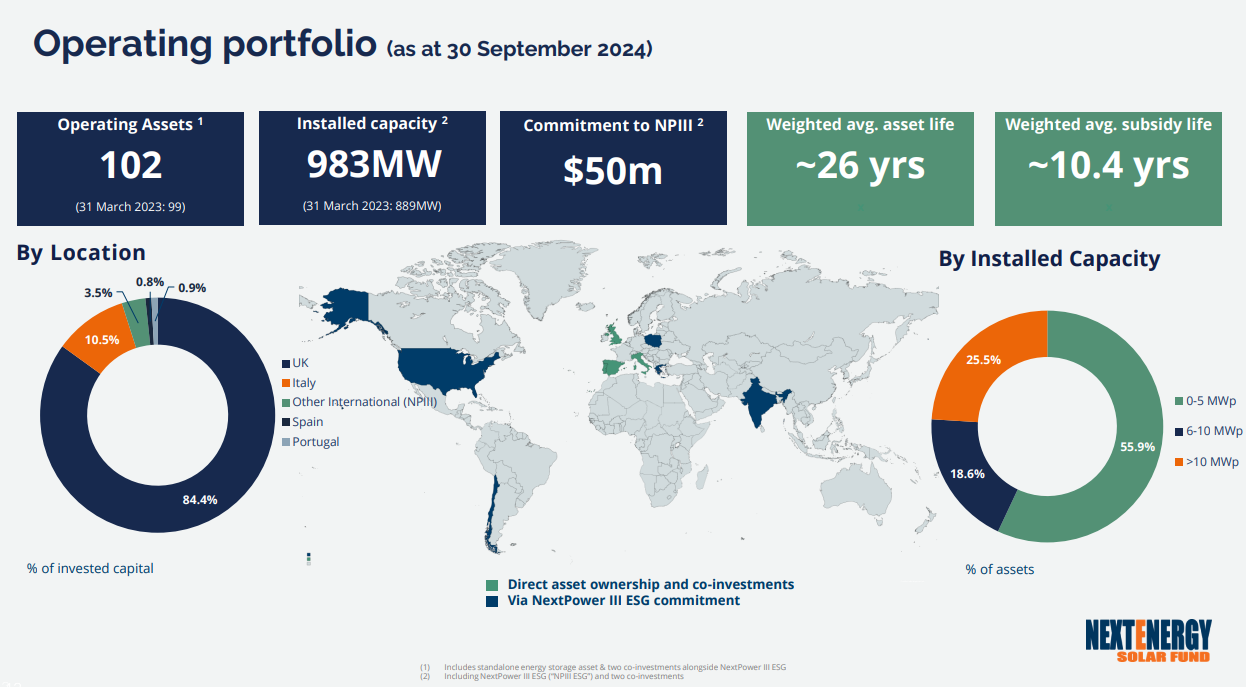
Consider that electricity demand will increase by 56% over the next 10 years.
Yet we see the “experts” proclaim that the NAV should be reduced by -£17.8m due to gas prices and short-term power demand expectations.
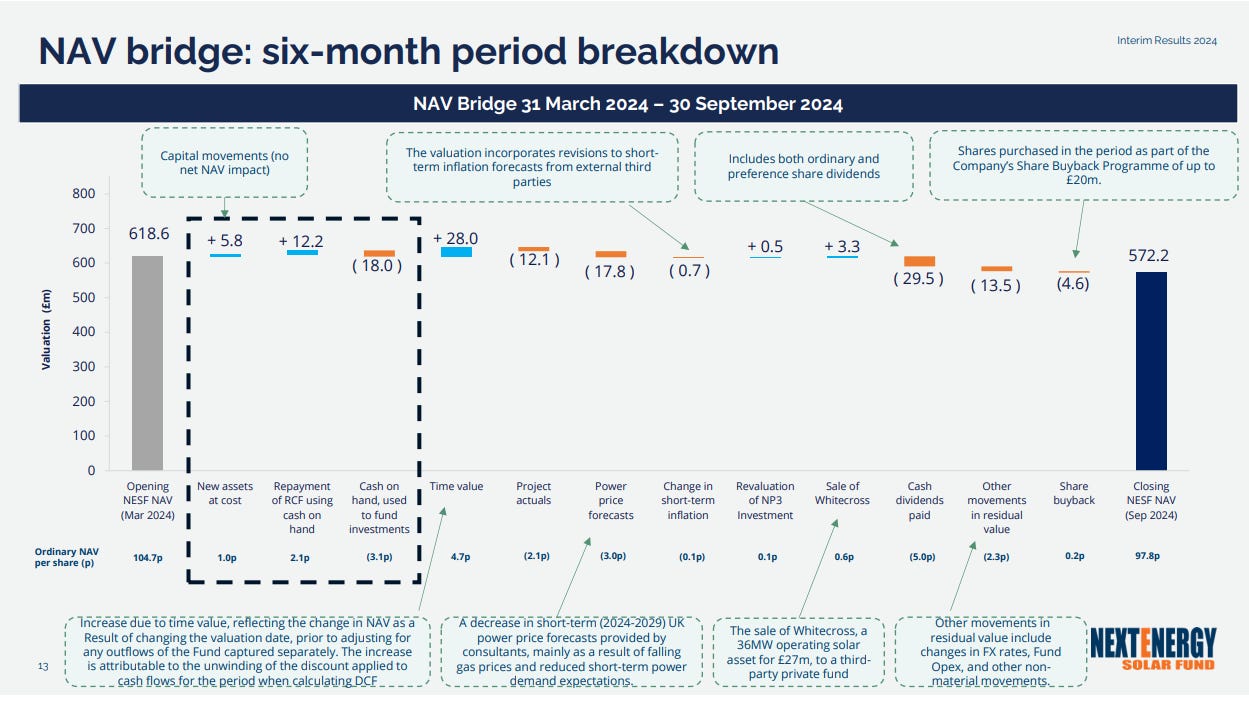
2024 consumption was higher than than 2023. Perhaps the “experts” are a little confused over what NESF sell? Solar Panels do not produce Natural Gas but power experts do appear to emit hot air.
Meanwhile the Dept for Energy Security & Net Zero tell us that consumption of Electricity is up and other forms of energy are down.

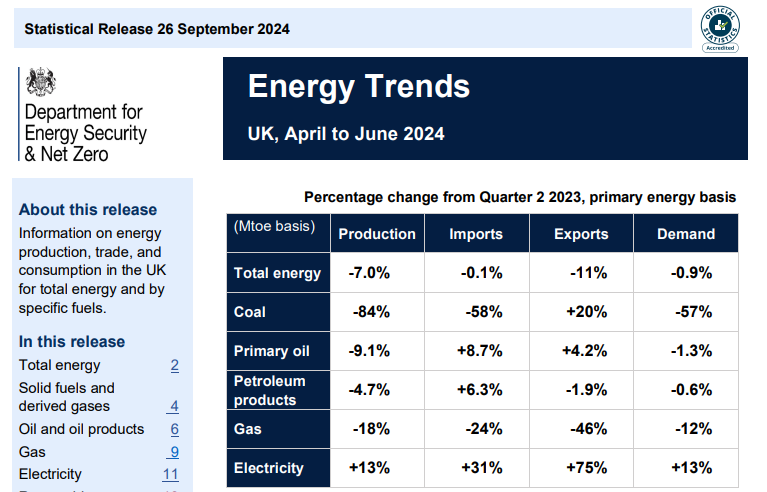
Energy storage assets are a growth area for NESF. These enable NESF to capitalise on existing infrastructure including existing grid connections and inverters, meaning OPEX is optimised, but also that solar generation can be sold at optimal times (i.e. early evening). The idea being that the 92 UK sites could be retrofitted over time with energy storage. Currently 1 50MW site live, a second pre-Construction of 250MW, a smaller 6MW co-located storage 1 has planning, and 4 applications are in progress.
Interestingly, the power price forecasts include a “solar capture” discount, which reflects the discount on pricing in daylight hours versus during baseload hours. With the introduction of storage such a discount would disappear – so create a positive reversion for the NAV that not only do you add the asset to the NAV but you also remove the solar capture discount too.
NESF reveals substantial drops due to discount rates increasing to 8% and short term power prices falling also.
When you strip out that “noise” and focus on the real movements roughly inflation protections offsets power price forecast changes, income nearly covers dividends (and in the 25% higher irradiance in 2022 would have fully covered the dividend), while asset capital gains offset project losses and other losses.
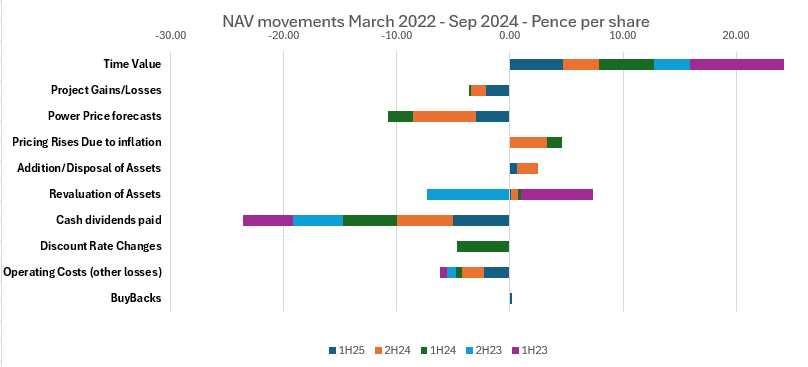
Looking forward it appears that Power Price forecasts will eventually return to a positive, as will the discount rate. It wasn’t clear to me that the forecasts are considering the subsidies, the ROCs and the hedges that NESF employ. Much of current year is hedged and several years ahead also.
A further proof point is that the fund is selling assets at a premium is a strong proof point. But I considered simply following the money.
Now with the HoldCo and the obfuscation that goes on that’s easier said than done. But I persevered and think I managed to find some good insight.
It was at this point I decided tempting NESF was not going to be an Oak Bloke 2025 idea after all.
Why?
What was the “but” for the Oak Bloke?

In the yellow line I took the income (I’ve doubled the numbers for 2025 because we only have the interim result) and then I deducted the overheads but also calculated the depreciation by taking the difference of the HoldCo EBITDA and EBIT.
All looks really positive doesn’t it? But what if we consider depreciation AND dividends.
Ouch.

If NESF didn’t operate the obfuscating HoldCo structure this is what I believe the real picture would look like.
The “real profit” where we hope income exceeds the replacement cost of capital. And it does. However this real profit needs to pay dividends and it doesn’t fully cover that.
Also of concern “Investment Income” is down in FY25. There is a degree of further obfuscation by NESF as to the reasons why.
Part of the reason for this fall is the extent of the actual vs budget output.
If you look at the “expected” values in the chart below the differences add to nearly 40GWh or 7% of the budget. The report speaks to a 4.5% below budget (excluding i.e. plus factors outside NESF’s control). So 2.5% was beyond control perhaps.

Certain metrics like cash flow appear pleasing – that the assets can generate a cash return able to cover the dividend. Moreover I also observe a comment about the 25 year life of assets and the fact that there’s no reason why the assets cannot be used beyond 25 years – subject to lease agreement and also to replace defective parts. NESF do speak to doing this – and nowhere is that in the price. Given the assets are around 10 years old extending 25 year old assets to a 30 year life would drop depreciation by a third – or £15m per annum. The sale of assets at a premium could be explained by the depreciation policy simply being too aggressive.
But the problem is I just don’t know if that’s the case, or at what cost.

Taking the FY25 real cash flow as earnings values NESF at 12X at today’s share price.
But the EBIT of £82.4m doesn’t reconcile with the reported earnings. If I instead use the “real profit” earnings FY22-FY25 of £23m the calculation is nearly 18X the share price.
Whilst NESF offers a great dividend and is selling its assets at a premium I am concerned when I value this on a simple cash generation minus depreciation minus dividends basis.
I find the numbers are not sustainable. To determine the income I’ve used the £15.2m cash returns plus £6.5m dividiends from HoldCo to TopCo.


I’ve reviewed a lot of comments in the chattersphere. No one seems to have noticed the drop in income!

What I saw as boring and safe with upside I now see as fairly valued at the current price. The nearly 50% drop in “investment income” worries me. Arguably dropped over what is potentially the better 6 months of the year too (the summer months).
The fact that NESF don’t address this anywhere worries me. The moving of some returns to repayment of intercompany loans could be a way to hide the evidence?
The 7% fall in availability will explain part of the reason it’s sure. The lower 6.9% yield is connected and will explain part of it too. But why not just be open about that?
Perhaps the other reason for the fall in income is that power prices are falling and the UK is about to enjoy years and years of cheaper electricity after all. Labour did promise cheaper bills didn’t they? Right now we are in the midst of a colder winter for Europe in 2024 and my power prices just increased. With our new government knifing Oil & Gas in a populist tax grab of a globally leading 78% margin rate I’d be surprised if it’s the reason. Plus what about all the subsidies and PPA pricing?
But again we simply don’t know.
I conclude to say I would question the sustainability of the dividend. It is “covered” only if you ignore depreciation. In other words NESF is eating its seed corn by paying current dividends.
After coming close to including it, NESF is not one for the OB 2025 ideas, despite the alluring attractions. (the OB idea SEIT does stand up to this same scrutiny by the way)
Will this be the final episode for NESF? 8pm on Christmas day is when all’s said and done (including the incident on the boat maybe?).
Regards,
The Oak Bloke
Disclaimers:
This is not advice
© 2025 Passive Income
Theme by Anders Noren — Up ↑